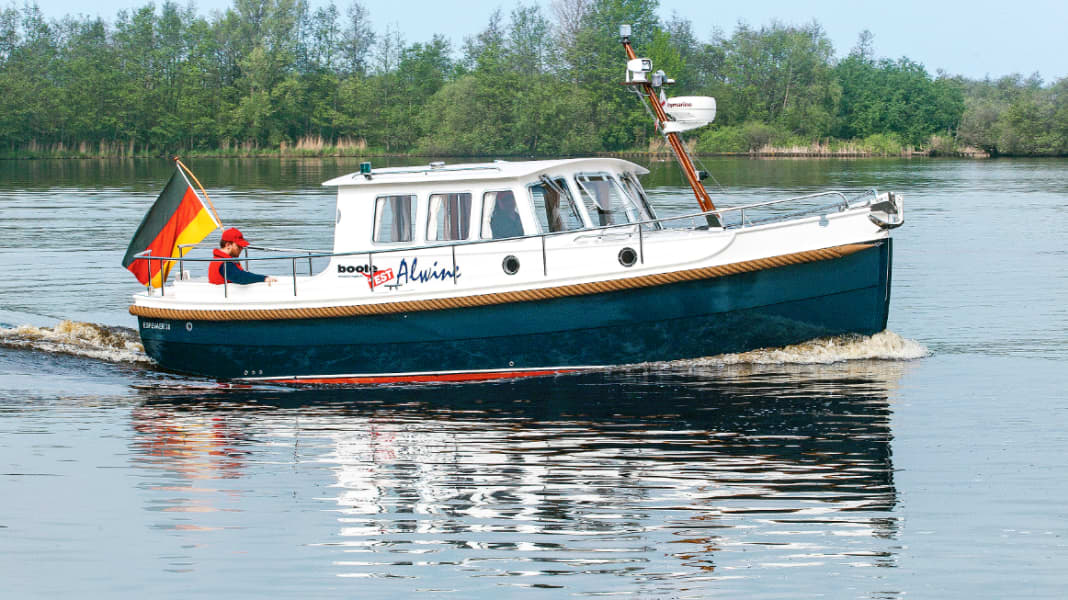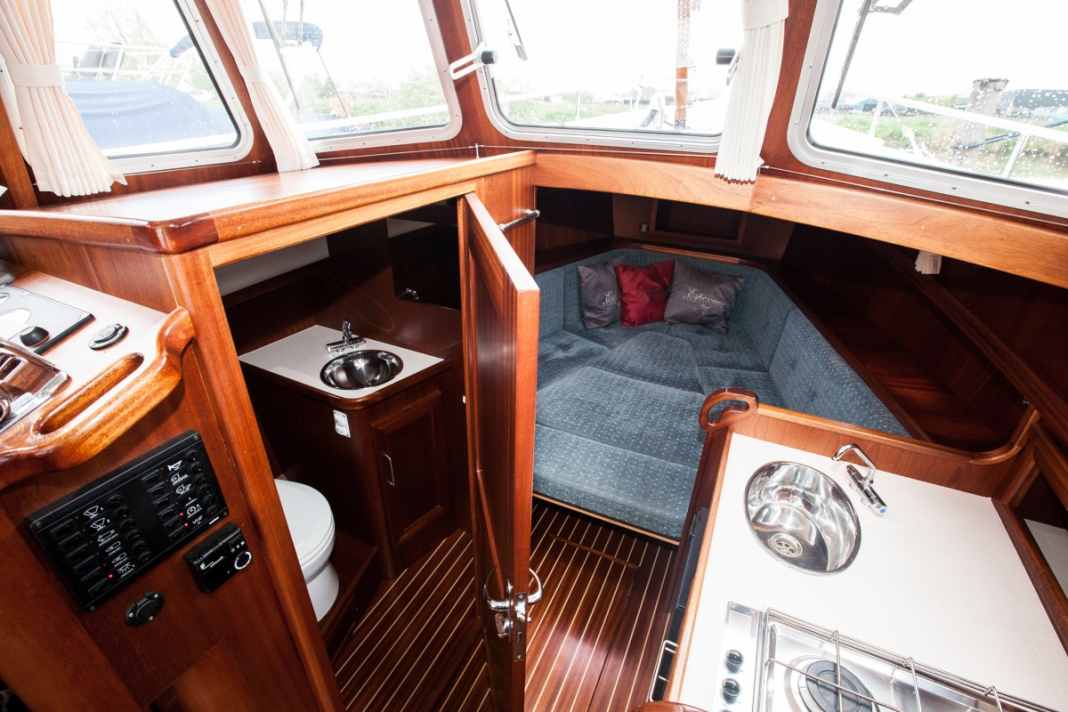







Espevaer is not one of the best-known names when it comes to Dutch steel boatbuilding. It is manufactured and sold in the Friesland region. - We took our test boat out on the waters around Grou, where the dealer Wassersport Goos is based. Klaas Goos "looks after" Espevaer with three other boat specialists; in addition to "our" 28, they also offer
an Espevaer 32 and two sloops. Our test boat has a classic layout for two people who want to travel in comfort. This includes a seat/berth combination in the bow, wet room, galley with seating area and a cockpit. With CE category C, the boat is suitable for canals, rivers, lakes and coastal waters. - Its workmanship (welded seams, paintwork and fittings) is impressive across the board.
Driving and manoeuvring
It almost goes without saying that such a solid steel boat is equipped with a diesel engine. A 39 hp Yanmar sits in the engine compartment as standard, but we sailed with the 54 hp and 5500 euro more expensive 4JH4E, which allows the 28 to plough through the water at a maximum of 7.5 knots. As this value is higher than the theoretical hull speed, the Espevaer throws a powerful wave, which flattens out considerably at a speed of around 2000 rpm (just under 6 knots). In this situation, the standard tank capacity (160 litres) is sufficient for more than the 200 nm we require plus 15% reserve. Our test boat was even equipped with double the amount of fuel, making it an absolute endurance runner.
There is also no hectic at the driving position, as the torso runs straight ahead on track. When two people move from one side to the other, it makes a small swerve in the direction of weight transfer. After a bend, the rudder angle indicator on our test boat proves particularly useful. It allows you to find the straight-ahead course again in no time at all. In fast bends, the Espevaer only leans a little on the outside of the bend, turns almost upright and swings easily into its own wave. The steering is particularly smooth. When manoeuvring slowly, the 28 behaves typically for a boat with shaft drive, with large turning circles when engaged backwards and sluggish reversing behaviour. -There was no rough water, so no judgement was made on this point.
Although the sound level is good when cruising, an oscillating noise from the exhaust is noticeable, especially just below 2000 rpm, which is annoying in the long term. This applies both in the cockpit and at the driving position. At the latter, the skipper is best positioned in order to have unrestricted manoeuvrability, because if you sit on the free-standing stool, your knees quickly bump into the steering wheel. The single-lever control and the bow thruster are easy to operate from any driving position.
What is annoying are the wide roof struts, which give the curtains additional space and thus obstruct the view to the front. Two sufficiently large windscreen wipers provide the necessary visibility when driving in the rain. The driver has an almost mirror-free view of the instruments. The navigation instruments are criticised because they are not included as standard. The electrical consumers are operated via a switch fuse panel on the side of the driver's cab when passing through to the front.
Engine, tank, electrics
"Open the hatch to access the engine, which is compactly embedded under the cockpit floor. Changing the V-belt and replacing the impeller is awkward due to the proximity to the bulkhead; the rest can be accessed easily. Cleaning the water filter in the cockpit locker is particularly easy. The lines in the engine compartment are neatly laid out on cable platforms and professionally strain-relieved under the driving position. Exemplary: the installation of a filter cartridge with sight glass and drain tap as well as the standard stopcock and hose attachment with two screw clamps. The on-board power supply and starter battery are securely mounted in the steel frame with sturdy retaining straps plus bow thruster battery. The main switches are also located within easy reach in the forecastle box.
Security
Not only is there an emergency tiller so that you can continue to operate the boat if you have problems with the steering, but there is also a single-lever control and bow thruster control panel that turn the cockpit into a second helm station. Standing skippers have a good view forwards, but have to clamp the tiller between their legs to operate it. If you want to sit while driving, you have to slide to the side to look past the cabin.
The safe route to the cockpit leads from the front via the side decks with a sliding edge, railing, hand recesses in the roof overhangs and handrails on the cabin roof to the forecastle boxes. An access point is cut out in the stern railing, which is used to reach bathing ladder steps welded to the stern. A further step, which guarantees easy entry and exit from the water, is located under water directly at the rudder. The safety equipment includes a hand bilge and electric pump and the cockpit, which can be steered outboard. The fire extinguisher fulfils our BOOTE standard.
Living and equipment
There were no cushions on the cockpit benches (owner's request); the table is a free-standing model. The driver's cab, with the passenger bench installed lengthways to the direction of travel, is accessed via a double wing door; there is a huge storage space under the bench. The galley, seating area and wet room are installed one floor below. The latter can only be accessed from the driver's cab, as the toilet door slams forwards, "gets stuck" on the galley and blocks the passageway. The washroom is equipped with a pump toilet (electric), stainless steel washbasin and sufficient storage space. The room lacks headroom and a shower.
The galley is practically equipped and can be used reasonably well. Food is served on a wooden table with a sliding edge at the seating area in the bow. The seats at the very front are ideal for "lounging", as this is where the seating depth is greatest. The cushions have good firmness, and three centre posts create a cosy double berth (without ventilation). - From the outside, the Espevaer 28 makes a "ship-like impression", which is not least due to the standard mast. Bollards for mooring and the thick wieling do the rest. There is a "Bruce" with bow bracket for anchoring.
THE SHIPYARD SAYS...
Espevaer boats are developed by an experienced team and can be customised to the customer's needs. The 28 is suitable for inland and coastal areas and offers an attractive interior and excellent sailing characteristics.
WE SAY...
We agree with the shipyard on the sailing characteristics and the area of use. The interior of our test boat had a very classic design. We were not convinced by some of the details, such as the wet cell entrance. However, the safety equipment and the workmanship of the test boat definitely deserve praise.
Data sheet: Espevaer 28
Shipyard: Espevaer Jachtbouw
Type designation: Espevaer 28
CE category: C - Coastal waters
Material of hull and deck: Steel
Length: 8,40 m
Width: 3,10 m
Displacement: 6,40 t
Price: 125.000,00 €

